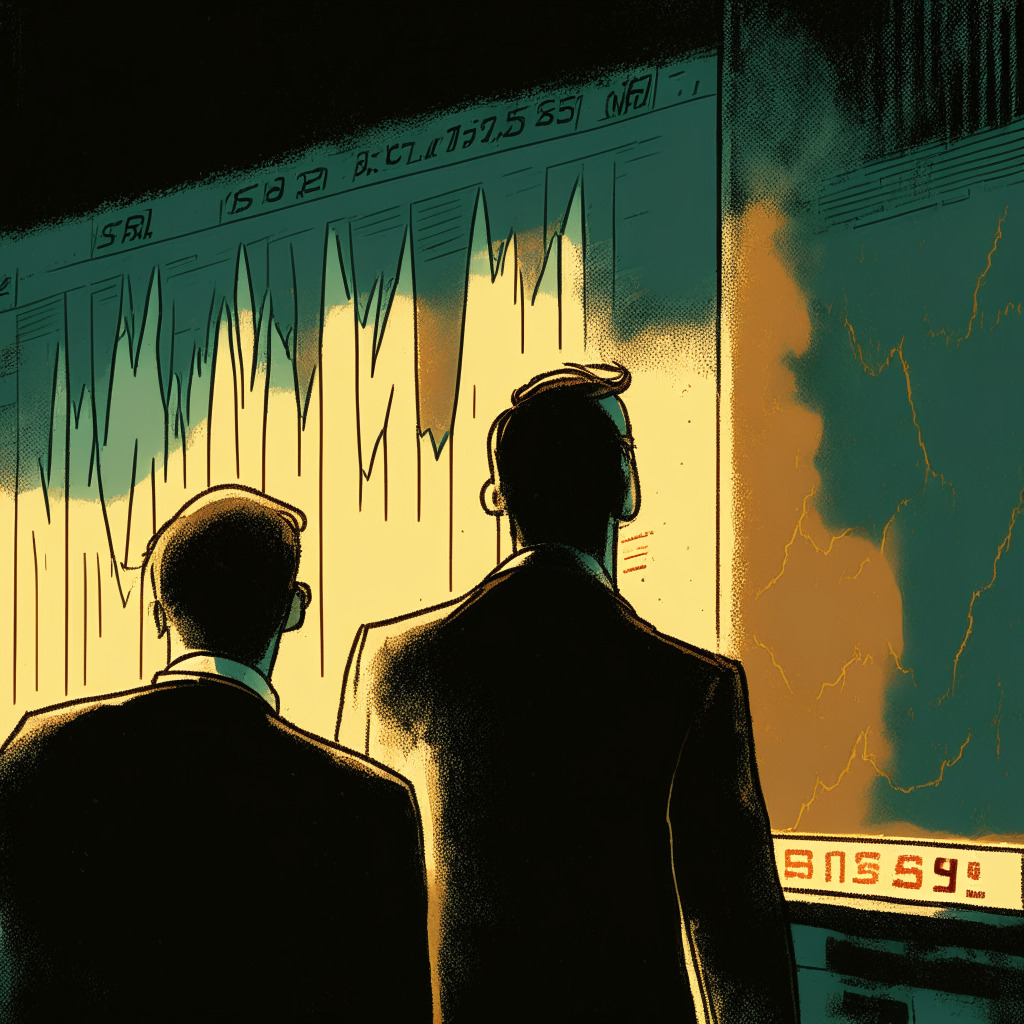According to a technical analysis, Bitcoin appears to be severely oversold, indicating a precipitous price drop. The 14-day relative strength index (RSI) is below 30, a situation unseen since the market crash in March 2020. Alex Kuptsikevich, a senior market analyst, confirms a shift to a bearish trend, advising not to misinterpret oversold RSIs as a bullish reversal signal.
Search Results for: SWIFT
Blockchain Battleground: How High Interest Rates Impact Bitcoin Value and the Investor’s Dilemma
The recent plunge in Bitcoin’s value is linked to strengthening economic metrics which could lead to extended high interest rates. The speculation around higher neutral interest rates and potential inflation rate increases spooked the cryptocurrency markets, resulting in a drop in Bitcoin’s value.
Unraveling the Impact of Vitalik Buterin’s Million-Dollar ETH Transfer
“The move by Ethereum’s co-founder Vitalik Buterin to transfer $1 million worth of ETH to Coinbase has sparked intrigue and speculation within the crypto fraternity. Amid market volatility, this transaction raises questions about the influence of market moguls and the essence of cryptocurrencies, underscoring the sector’s sensitivity, volatility, and commitment to freedom of trade.”
Decentralized Social Media vs Meme Coins: Qrolli’s Growth and Wall Street Memes’ Potential Risks
“Friend Tech’s Qrolli, a decentralised media platform, empowers content creators with monetized content, NFTs, and more. Meanwhile, Wall Street Memes, an anticipated 2023 meme coin, pays homage to anti-bank sentiment, with tokens dedicated to community rewards and presale.”
Impact of Token Unlocks on Market Price: A Breakdown of Recent Release Events for LDO, AVAX and YGG
Lido (LDO), Avalanche Blockchain token (AVAX), and Yield Guild Games DAO token (YGG) will experience substantial token unlock events this week, signaling a potential surge in market token supply. LDO plans to unfreeze 8.5 million tokens, while AVAX and YGG are set to release 9.54 million and 12.2 million tokens respectively. This highlights both the promise and complexity of unlock events’ impact on market trends.
Exploring China’s Digital ID Proposal: The Implications for Anonymity and Privacy in the Metaverse
“China proposes to extend their social credit system into the Metaverse using a digital ID for users, aimed at upholding order by storing and sharing user data with authorities. However, concerns about maintaining anonymity and privacy challenge such proposals, necessitating a balance between order and user rights.”
Navigating the Stormy Seas of Cryptocurrency: Future of Bitcoin amidst Heavy Price Swings
“The Bitcoin price, currently around $25,882, exhibits potent bearish sentiment, indicated by ‘Three Black Crows’ candlestick patterns and oversold RSI and MACD oscillators. The 50-day EMA, resistance at $26,200, and other technical pointers suggest further potential declines.”
Navigating Bitcoin Adoption in El Salvador: Opportunities and Challenges Unraveled
“During a trip to El Salvador, I saw innovative strategies to make Bitcoin more economically feasible, even for smaller investors. Key advancements like Lightning-enabled ATMs convert fiat to bitcoin with reduced costs, encouraging wider Bitcoin adoption. However, with Salvadoran banks’ legacy systems, non-bank services are crucial in facilitating digital currency acceptance.”
Navigating the Aftermath: Dealing with the $12M Curve Exploit Loss in Crypto Lending
JPEG’d, an NFT-collateralized lending app, recently lost nearly $12 million in a Curve exploit. The swift recovery action led to the return of 90% of funds, but left a significant unresolved loss. The event highlights the vulnerabilities and risk management requirements in the dynamic crypto realm.
Crypto Carnage: Unraveling the Aftermath of BTC’s Bleak Week and the Legal Standoff with Grayscale
Last week was particularly harsh for BTC, plunging nearly 11% amidst a potential legal ruling involving Grayscale and U.S regulators. The continuous case continues to cloud over BTC’s market position. Similar downturns were experienced across the broader crypto market, largely due to devastating market structures or macroeconomic factors.
Merging Finance and Blockchain: eToro’s Radical Shift versus Elon Musk’s Risky Maneuvers
“Yoni Assia, eToro’s co-founder, embraced financial technologies to democratize trading. eToro, under his steer, simplified brokerage account set up, enabling users to start trading swiftly. Influenced by programmer Vitalik Buterin, eToro introduced Bitcoin trading, aiding in a blockchain industry transformation.”
Celsius Asset Sale: Bankruptcy, Scandal, and the Potent Future of Self-Regulated Crypto
In the saga of the troubled crypto lender, Celsius, a vote on the firm’s asset sale proposal to the Fahrenheit consortium is approaching. The court approval of the proposal indicates that creditors could recoup between 67% to 85% of their investments, amidst ongoing turbulence including former CEO, Alex Mashinsky’s contentious arrest, and a hefty FTC fine.
Bitcoin’s Unexpected Dive: Interplay of Fed’s Inflation Concerns, Bearish Traders and Falling Yields
Bitcoin’s price dropped below $29,000 on August 16, its lowest in eight weeks, possibly due to bearish traders, FOMC’s inflation concerns, and potential interest rate increases. The looming expiration of $580 million Bitcoin options added to the downward pressure and complicated the cryptocurrency’s price correction strategy. Despite the uncertainty, Bitcoin might reverse its falling trend after the weekly options expiry.
Clashing Giants: Gitcoin and Shell’s Controversial Partnership for Blockchain Climate Solutions
The blockchain platform Gitcoin and oil-rich Shell have formed a controversial partnership aimed at developing “open-source climate solutions.” Many critics within the crypto community view this alliance as questionable, indicating that the intersection between advanced blockchain technology and ethical responsibility remains a significant challenge.
Decoding the Decreased Volatility of Bitcoin and Ethereum: A Hopeful Sign or a Major Risk?
The top cryptocurrencies Bitcoin and Ethereum are reportedly less volatile than oil, with BTC and ETH’s volatility at 35% and 37% respectively, while oil’s volatility stands at 41%. This lower volatility might lead to market stability and consistent growth but also signals potential large price movements. Despite similarities, Bitcoin and Ethereum’s differing fundamentals suggest unique trajectories.
BitGo’s $100 Million Series C Funding Ignites Crypto Custody Expansion Buzz
BitGo, a crypto custody services provider, has secured $100 million in funding boosting its valuation to $1.75 billion. This capital is targeted for strategic acquisitions and international expansion, in response to the growing demand for crypto custody services globally.
Unleashing the Bull: An In-depth Analysis of XBULL’s Surge & The Rise of Wall Street Memes
“Decentralized exchange market newcomer, XBULL, experienced a +1,000% surge on launch, bolstering its profile significantly. Meanwhile, Wall Street Memes ($WSM), a tokenized representation of the anti-bank movement, is gaining investor interest with its explosive growth, +30% presale guarantee, and promise of significant returns. However, given the volatile nature of the crypto realm, caution is advised.”
Crypto Market Shifts: Are Bulls or Bears Gaining Ground?
“Amidst market fluctuations, cryptocurrencies like Bitcoin and Ethereum experienced value shrinkage. While Bitcoin’s low trading signifies potential bear market, Ethereum’s slump further bolsters the possibility. Despite uncertainties, the evolving dynamics of this landscape in relation to global economy are important to track.”
Bitcoin’s Fee-to-Reward Ratio: Balancing User Experience, Security and Sustainability
Bitcoin’s fee-to-reward ratio critically impacts transaction speed, network security, and overall stability of the blockchain. In times of heavy traffic, users potentially pay more for quick verification, fostering network efficiency and aiding miners’ profitability. Ultimately, this ratio could dictate Bitcoin’s future economic sustainability.
SEI’s Market Momentum: Surges, Slumps, and Future Prospects of Cross-Chain Trades
“The Sei network, a new layer-one blockchain, saw its SEI token surge by 29% within a 24-hour span. The primary goal of Sei is to facilitate quick cross-chain trades and transactions. An airdrop of free SEI is planned, targeting users from various networks. Additionally, promising new altcoin Sonik Coin, based on Ethereum, offers staking rewards and engages investors with quirky marketing.”
DeFi’s Meme-Coins: Case of Cookie Coin and Wall Street Memes – A Bullish Turn or Unstable Mirage?
Within the decentralized finance realm, Dex Coins like Cookie Coin (COOKIE) built on Coinbase’s new layer-2 blockchain have grabbed attention with their astronomical price hikes. While it’s noteworthy to acknowledge COOKIE’s 5000% price surge, it’s equally important to note the success of other meme-coins like Wall Street Memes which raised $25 million during its presale. This signifies an intriguing new dimension to the crypto market.
Central Bank Digital Currencies: Revolutionizing Cryptocurrency or a Stealthy Threat?
Central Bank Digital Currencies (CBDCs) reflect increasing public acceptance of digital assets. Currently, 11 countries have integrated CBDCs, with 130 more exploring the possibilities. Their introduction might push blockchain technology further into the mainstream, validating digital currencies’ utility and benefits. However, there’s concern over potential risks to personal freedoms and privacy.
Singapore Central Bank’s Stablecoin Guidelines: Pros, Cons and the Future of Blockchain Regulation
Singapore’s central bank, the MAS, unveils its regulatory framework for stablecoins, endorsing a three business day timeline for single-currency stablecoin transfers, similar to regular domestic money transfers. Critics argue this fails to fully leverage blockchain’s instantaneous transaction capabilities, suggesting regulatory flexibility is needed to harness the technology’s full potential.
FDIC Highlights Crypto Risk: The Crossroads of Innovation and Vulnerability
“In an act of unprecedented vigilance, the United States banking system has been alerted to the ‘novel and complex’ risks presented by cryptocurrencies, highlighted in a recent report by the Federal Deposit Insurance Corporation (FDIC). The FDIC has demarcated a critical area regarding digital assets risk in its annual risk review, focusing on the burgeoning and volatile crypto market.”
Crypto Celebrity’s Lawsuit Withdrawal: Embezzlement Allegations, Community Support, and Lingering Doubts
“In a surprising turn, Taiwanese music celebrity Jeffrey Huang withdrew a defamation lawsuit against internet investigator ZachXBT, after revisions to an article sparked tensions. This incident underscores the crypto community’s volatility, the importance of reliable information, and raises questions about truthfulness.”
Navigating the Crypto Roller Coaster: The Rise of XRP20 vs. The Fall of Rollbit Coin (RLB)
GambleFi is impacting crypto markets, with attention on the Rollbit coin (RLB), experiencing a 40% drop prompting concerns about its value. However, indicators suggest potential consolidation of the coin’s value. In contrast, Ethereum-compliant XRP20 is attracting interest, promising income from staking and capital appreciation potential, introducing a transaction burn mechanism for added appeal.
Future of Bitcoin Spot ETFs: Pending Regulations and Political Influence’s Role
“Former SEC dignitary John Reed Stark speculates that the approval of Bitcoin Spot ETFs may be improbable due to regulatory hurdles. Despite Bitcoin price fluctuations, Stark believes a shift in political power towards Republicans could favor the crypto industry, potentially easing regulatory constraints and focusing more on fraudulent activities rather than registration violations. A move that could see Hester Pierce – ‘Crypto Mom’ – ascend the ranks, advocating for more crypto-friendly regulations.”
Coinbase’s Layer-2 Network Challenge: Balancing Blockchain Complexity with User Experience
Coinbase’s CEO, Brian Armstrong, recently addressed user experience (UX) issues surrounding its application, specifically for non-fungible tokens, decentralized apps, and layer-2 operations. The company’s commitment to user feedback, swift problem resolution, and focus on UX improvement is also propagating hope for the entire blockchain sector’s advancement.
Blockchain Paradox: The Potential and Pitfalls of BTC, ETH, BNB, XRP, ADA and USDT
“The world of cryptocurrency, including BTC, ETH, BNB, XRP, ADA, and USDT, hold opportunities and threats. Volatile prices hold promise for vast returns but can present disastrous losses. While cryptocurrencies offer solutions, their susceptibility to hacking raises security concerns.”
Unmasking Blockchain: Unveiling Its Potentials and Inherent Limitations
“The world is swiftly embracing blockchain technology, reflected in the rising value of cryptocurrencies. Blockchain eliminates the need for a central authority, resulting in a transparent, secure environment, and reduced transaction times and costs. However, this technology has potential flaws including its complexity, potential for illicit activities, and substantial energy consumption.”
Xverse Raises $5 Million, Aims to Fuel Bitcoin’s Mainstream Adoption: Risks and Rewards
Hong Kong-based startup Xverse, provider of the Bitcoin Web3 wallet, has raised $5 million in seed funding to facilitate the mainstream adoption of Bitcoin. The funds will drive DeFi and Bitcoin scalability solutions, sparking opportunity for the Bitcoin realm to expand.
Ripple Joins BIS Task Force Amid SEC Turmoil: Revolution or Corporatization of Crypto?
Ripple announced its partnership with the Bank for International Settlements (BIS), joining the BIS’s Payment Interoperability and Extension (PIE) task force. The inclusion of Ripple aims to improve cross-border payments, aligning with the task force’s objective of enhancing payment systems globally. However, uncertainties lie in Ripple’s ongoing court dispute concerning the status of XRP as a security.































